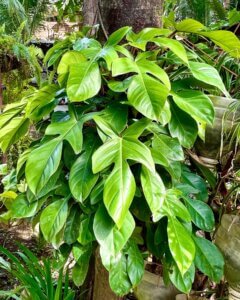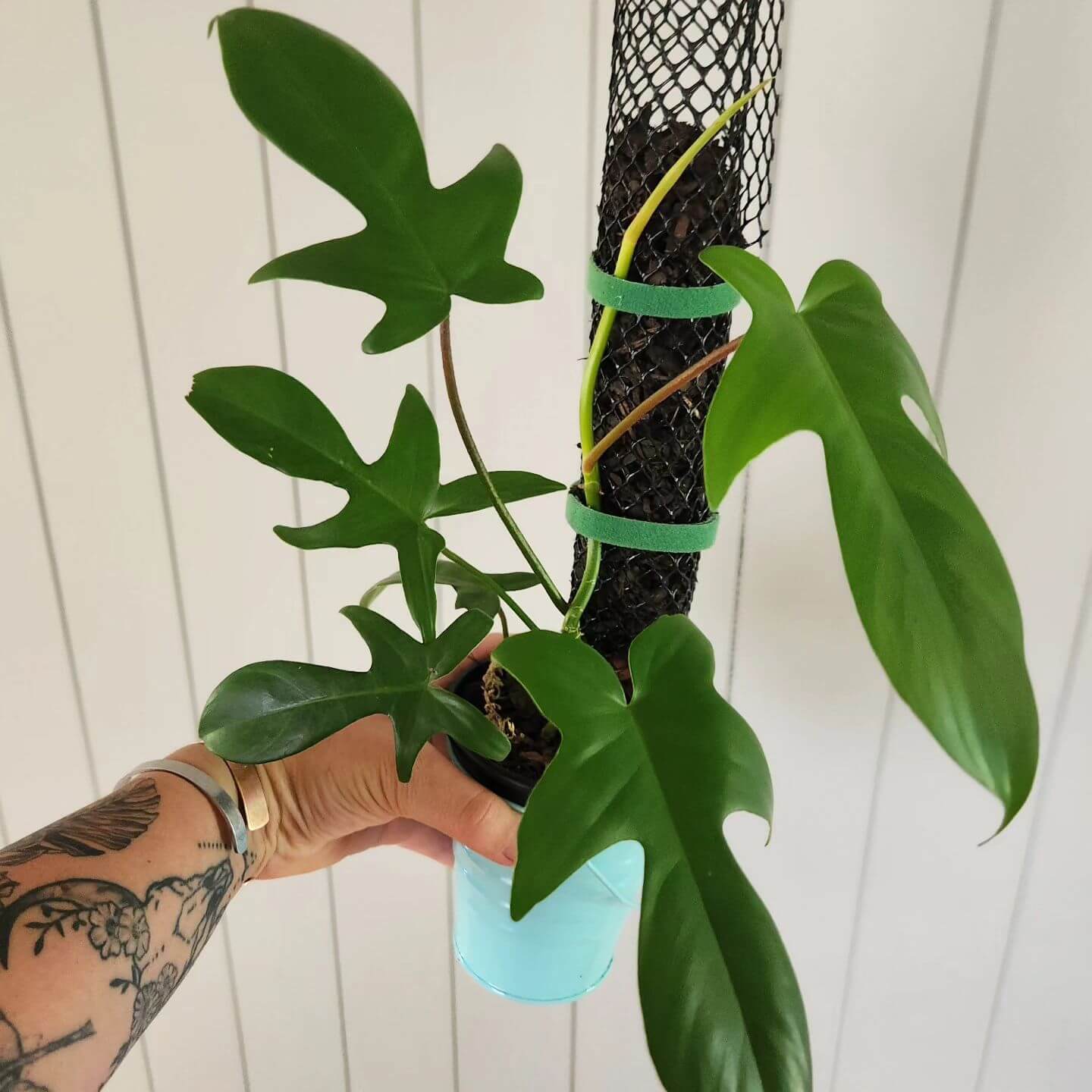Basic Information
Philodendron Florida is a climbing plant with green lobed leaves. It is easy to care for and grows fast, making it an ideal choice for a moss pole or totem.



Light
Philodendron Florida Beauty plant needs at least 6 hours of bright and indirect light every day to grow well. The best place for the plant to thrive is near an east-facing window where it can receive optimal light. However, if the windows are south- or west-facing, you can still make it work by adjusting the plant’s position or adding sheer curtains. Make sure not to expose the plant to harsh, direct sunlight, as it may damage the leaves and the plant itself. If the plant doesn’t receive enough indirect sunlight, its leaves may become more petite and leggy, and the leaves may not develop properly. You can counteract this by providing the plant with 8-10 hours of LED grow lights every day.
Water
This particular plant requires sufficient watering to keep the soil moist but not waterlogged. To check if your plant needs watering, test the soil and ensure that the top two inches of soil are dry before watering it thoroughly. The best time to water your plant is when the leaves wilt. Water it more frequently during the growing season, which is in spring and summer. However, it reduces the frequency of watering during winter. A pot with drainage holes is recommended to prevent water accumulation and promote air circulation. Signs of over or under-watering include wilting or discoloration of leaves. Check the soil for dryness every few days and water accordingly, as you can never rely on a schedule!
Tip: To check if a plant needs watering, lift it up. If it feels light, it’s time to water it.
Soil
For growing Philodendron Florida Beauty, it is important to use a growing medium that drains well. Though philodendrons are not too particular about the soil they grow in, they tend to do best in potting light, loose, and nutrient-rich soil. A recommended blend for this purpose includes sphagnum moss, perlite, and small particles of bark or vermiculite, such as coco-coir, peat moss, or shredded leaves. This mixture ensures adequate aeration and drainage while maintaining the necessary moisture levels.
Temperature
The ideal temperatures for this plant during the day should range between 60 to 70°F (16 to 21°C), while at night, it should be between 50 to 60°F (10 to 16°C). Although it can withstand mild frost, it should not be exposed to temperatures below 50°F (10°C). Additionally, it’s important to keep the plant away from drafty areas and air conditioning vents as this can cause its leaves to drop.
Humidity
Philodendron Florida is a tropical plant that can also thrive as an indoor plant in relatively dry conditions. However, it will benefit from higher humidity levels, ideally between 60% to 70%. Your plant may require extra hydration if you live in a dry environment. You can use a humidifier or a pebble tray or relocate the plant to a more humid area like the bathroom to maintain the moisture level in the air and ensure its good health.
Fertilizer
To keep your Philodendron Florida healthy and thriving, it’s recommended to fertilize it with a liquid fertilizer once a month during spring and summer. This can be reduced to once every 6 to 8 weeks during fall and winter. Before fertilizing, water the soil thoroughly to avoid root burn.
For the best results, use a nitrogen-rich fertilizer and dilute it to ¼ of the recommended strength before application. This should be done every two weeks throughout the growing season. However, over-fertilization should be avoided at all costs, as it can cause damage to the plant.
Growth Rate
The Philodendron Florida Beauty is a climbing plant that can grow up to 90 feet (27 meters) in its natural habitat. When placed indoors, the Florida Green Philodendron is a moderate-growing plant that can take about seven or more years to reach maturity. To help support the aerial roots, provide a sturdy stake when the plant is young. Keep in mind that the Florida Green Philodendron can reach a height of 5 feet or more at maturity, so it’s important to prune it to keep its length manageable occasionally.
Pet Safety
Philodendron Florida Beauty is toxic to cats and dogs. Pets may show symptoms like diarrhea, depression, and excessive salivation if ingested. Keep the plant out of reach to prevent accidental ingestion.
Grow in Semi-Hydro
- Philodendrons, celebrated for their lush foliage and adaptability, thrive in semi-hydroponic systems such as LECA/Pon, thanks to their resilient root systems and preference for consistent moisture.
- Shifting a Philodendron to a semi-hydroponic setting works well using a Nutrient Stagnant Wicking (NSW) method, providing a stable and effective environment for growth.
- Within the LECA/Pon environment, Philodendron roots adapt swiftly, effectively managing any early challenges in adapting to the NSW system.
- For nourishing Philodendrons in semi-hydro systems, a nutrient solution with a concentration around 800-1000ppm is optimal.
- Philodendrons are versatile in adapting to a range of temperature and humidity levels, making them ideal for various indoor settings.
- Regular care involves keeping an eye on the water level in the reservoir and periodically flushing the system to ensure the Philodendron’s healthy and consistent growth.
- If your Philodendron is a climber, it’s a must to look at our Moss Pole guide to have a proper set-up.
Tips
- To propagate, take stem cuttings and root them in water or soil for 2-3 weeks. For fuller growth, root multiple cuttings in the same container.
- Rotate your plant regularly to ensure even light exposure. Monitor the color of the leaves; if they start to look discolored, it may indicate that they need more light.
- Check soil moisture before watering. Drain excess water from cover pots after.
- To prevent accidentally spreading bacteria or pests, disinfect your pruners every time you use them on a new plant.
- Encouraging larger leaf development is possible by staking your plant to climb upwards.
- As your vining Florida Green Philodendron grows, it is normal for the lower leaves to turn yellow. You can remove them once you can pull them off by hand.
- Lastly, protect your plant from extreme temperature changes and drafty locations.
By adhering to these guidelines, your Philodendron Florida should thrive, showcasing its characteristic beauty and robust growth. Remember, it’s about finding the right balance to mimic its natural tropical habitat.
Happy planting! 🌱


